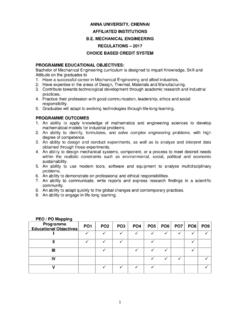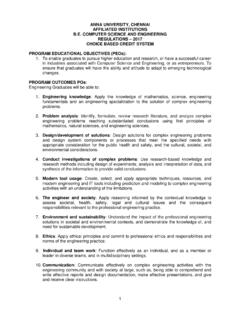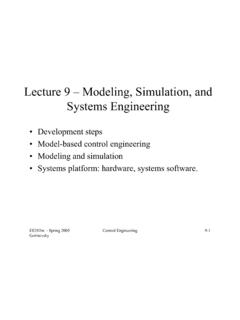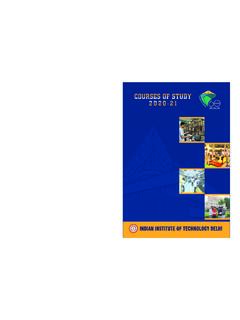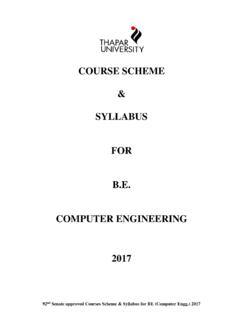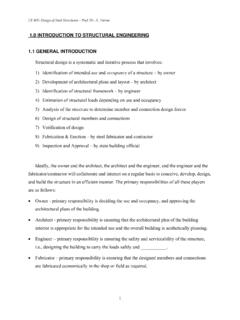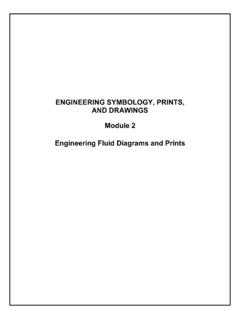Transcription of ANNA UNIVERSITY, CHENNAI AFFILIATED INSTITUTIONS B.E.
1 1 ANNA UNIVERSITY, CHENNAI AFFILIATED INSTITUTIONS ELECTRONICS AND COMMUNICATION engineering REGULATIONS 2017 PROGRAMME EDUCATIONAL OBJECTIVES: PEO1: To enable graduates to pursue research, or have a successful career in academia or industries associated with Electronics and Communication engineering , or as entrepreneurs. PEO2: To provide students with strong foundational concepts and also advanced techniques and tools in order to enable them to build solutions or systems of varying complexity. PEO3: To prepare students to critically analyze existing literature in an area of specialization and ethically develop innovative and research oriented methodologies to solve the problems identified.
2 PROGRAMME OUTCOMES: engineering Graduates will be able to: 1. engineering knowledge: Apply the knowledge of mathematics, science, engineering fundamentals, and an engineering specialization to the solution of complex engineering problems. 2. Problem analysis: Identify, formulate, review research literature, and analyze complex engineering problems reaching substantiated conclusions using first principles of mathematics, natural sciences, and engineering sciences. 3. Design/development of solutions: Design solutions for complex engineering problems and design system components or processes that meet the specified needs with appropriate consideration for the public health and safety, and the cultural, societal, and environmental considerations.
3 4. Conduct investigations of complex problems: Use research-based knowledge and research methods including design of experiments, analysis and interpretation of data, and synthesis of the information to provide valid conclusions. 5. Modern tool usage: Create, select, and apply appropriate techniques, resources, and modern engineering and IT tools including prediction and modeling to complex engineering activities with an understanding of the limitations. 6. The engineer and society: Apply reasoning informed by the contextual knowledge to assess societal, health, safety, legal and cultural issues and the consequent responsibilities relevant to the professional engineering practice.
4 7. Environment and sustainability: Understand the impact of the professional engineering solutions in societal and environmental contexts, and demonstrate the knowledge of, and need for sustainable development. 2 8. Ethics: Apply ethical principles and commit to professional ethics and responsibilities and norms of the engineering practice. 9. Individual and team work: Function effectively as an individual, and as a member or leader in diverse teams, and in multidisciplinary settings. 10. Communication: Communicate effectively on complex engineering activities with the engineering community and with society at large, such as, being able to comprehend and write effective reports and design documentation, make effective presentations, and give and receive clear instructions.
5 11. Project management and finance: Demonstrate knowledge and understanding of the engineering and management principles and apply these to one s own work, as a member and leader in a team, to manage projects and in multidisciplinary environments. 12. Life-long learning: Recognize the need for, and have the preparation and ability to engage in independent and life-long learning in the broadest context of technological change. PROGRAM SPECIFIC OBJECTIVES (PSOs) 1. To analyze, design and develop solutions by applying foundational concepts of electronics and communication engineering . 2. To apply design principles and best practices for developing quality products for scientific and business applications.
6 3. To adapt to emerging information and communication technologies (ICT) to innovate ideas and solutions to existing/novel problems. Contribution 1: Reasonable 2: Significant 3: Strong 3 MAPPING OF PROGRAMME EDUCATIONAL OBJECTIVES WITH PROGRAMME OUTCOMES A broad relation between the programme objective and the outcomes is given in the following table MAPPING OF PROGRAM SPECIFIC OBJECTIVES WITH PROGRAMME OUTCOMES A broad relation between the Program Specific Objectives and the outcomes is given in the following table PROGRAMME EDUCATIONAL OBJECTIVES PROGRAMME OUTCOMES A B C D E F G H I J K L 1 3 3 2 3 2 1 1 2 1 1 3 1 2 3 3 3 3 3 1 1 1 1 1 1 2 3 3 3 3 3 3 2 2 3 1 2 2 2 PROGRAM SPECIFIC OBJECTIVES PROGRAMME OUTCOMES A B C D E F G H I J K L 1 3 3 2 3 2 1 1 1 1 1 1 2 2 3 3 3 3 3 2 2 3 1 3 3 3 3 3 3 3 3 3 3 3 2 1 1 1 3 4 ANNA UNIVERSITY.
7 CHENNAI AFFILIATED INSTITUTIONS ELECTRONICS AND COMMUNICATION engineering REGULATIONS 2017 CHOICE BASED CREDIT SYSTEM MAPPING OF COURSE OUTCOMES WITH PROGRAMME OUTCOMES: A broad relation between the Course Outcomes and Programme Outcomes is given in the following table COURSE OUTCOMES PROGRAMME OUTCOMES Sem Course Name a b c d e f g h i j k l I Communicative English engineering Mathematics I engineering Physics engineering Chemistry Problem Solving and Python Programming engineering Graphics Problem Solving and Python Programming Laboratory Physics and Chemistry Laboratory II Technical English engineering Mathematics II Physics for Electronics engineering
8 Basic Electrical and Instrumentation engineering Circuit Analysis Electronic Devices Circuits and Devices Laboratory engineering Practices Laboratory III Linear Algebra and Partial Differential Equations Fundamentals of Data Structures In C Electronic Circuits- I Signals and Systems Digital Electronics Control System engineering Fundamentals of Data Structures in C Laboratory Analog and Digital Circuits Laboratory Interpersonal Skills/Listening &Speaking IV Probability and Random Processes Electronic Circuits II Communication Theory Electromagnetic Fields Linear Integrated Circuits Environmental Science and engineering 5 COURSE OUTCOMES PROGRAMME OUTCOMES Sem Course Name a b c d e f g h i j k l Circuits Design and Simulation Laboratory Linear Integrated Circuits Laboratory V Digital Communication Discrete-Time Signal Processing Computer Architecture and Organization Communication Networks Professional
9 Elective I Open Elective I Digital Signal Processing Laboratory Communication Systems Laboratory Networks Laboratory VI Microprocessors and Microcontrollers VLSI Design Wireless Communication Principles of Management Transmission Lines and RF Systems Professional Elective -II Microprocessors and Microcontrollers Laboratory VLSI Design Laboratory Technical Seminar Professional Communication VII Antennas and Microwave engineering Optical Communication Embedded and Real Time Systems Ad hoc and Wireless Sensor Networks Professional Elective -III Open Elective - II Embedded Laboratory Advanced Communication Laboratory VIII Professional Elective - IV Professional Elective - V Project Work 6 ANNA UNIVERSITY, CHENNAI AFFILIATED INSTITUTIONS ELECTRONICS AND COMMUNICATION engineering REGULATIONS 2017 CHOICE BASED CREDIT SYSTEM I - VIII SEMESTERS CURRICULA AND SYLLABI SEMESTER I SI.
10 No COURSE CODE COURSE TITLE CATEGORY CONTACT PERIODS L T P C THEORY 1. HS8151 Communicative English HS 4 4 0 0 4 2. MA8151 engineering Mathematics - I BS 4 4 0 0 4 3. PH8151 engineering Physics BS 3 3 0 0 3 4. CY8151 engineering Chemistry BS 3 3 0 0 3 5. GE8151 Problem Solving and Python Programming ES 3 3 0 0 3 6. GE8152 engineering Graphics ES 6 2 0 4 4 PRACTICALS 7. GE8161 Problem Solving and Python Programming Laboratory ES 4 0 0 4 2 8. BS8161 Physics and Chemistry Laboratory BS 4 0 0 4 2 TOTAL 31 19 0 12 25 SEMESTER II SI. No COURSE CODE COURSE TITLE CATEGORY CONTACT PERIODS L T P C THEORY 1. HS8251 Technical English HS 4 4 0 0 4 2. MA8251 engineering Mathematics - II BS 4 4 0 0 4 3. PH8253 Physics for Electronics engineering BS 3 3 0 0 3 4.
